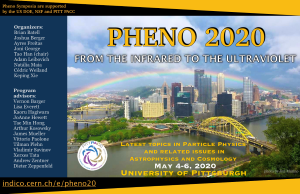Speaker
Description
We study the discovery prospect of different three body lepton number violating~(LNV) meson decays $M_{1}^{-}\to\ell_{1}^{-}\ell_{2}^{-}M_{2}^{+}$ in the framework of right handed~(RH) neutrino extended Standard Model~(SM). We consider a number of ongoing experiments, such as, NA62 and LHCb at CERN, Belle II at SuperKEK, as well as at the proposed future experiments, SHiP, MATHUSLA and FCC-ee. The RH Majorana neutrino $N$ mediating these meson decays provides a resonant enhancement of the rates, if the mass of $N$ lies in the range $(100\, \text{MeV}-6\, \text{GeV})$. We consider the effect of parent mesons velocity, as well as, the effect of finite detector size. Using the expected upper limits on the number of events for the LNV decay modes, $M_{1}^{-} \to\ell_1^{-}\ell_2^{-}\pi^{+}$~($M_{1}=B, B_c,D, D_{s}\,\text{and}\,K$), we analyze the sensitivity reach of the mixing angles $|V_{e N}|^{2}$, $|V_{\mu N}|^{2}$, $|V_{\tau N}|^{2}$, $|V_{e N}V_{\mu N}|$, $|V_{e N}V_{\tau N}|$ and $|V_{\mu N}V_{\tau N}|$ as a function of heavy neutrino mass $M_{N}$. We show that, inclusion of parent meson velocity can account to a large difference for active-sterile mixing, specially for $D$, $D_s$ meson decay at SHiP and $K$ meson decay at NA62. Taking into account the velocity of the $D_s$ meson, the future beam dump experiment SHiP can probe $|V_{eN}|^2 \sim 10^{-9}$. For RH neutrino mass in between 2 - 5 GeV, MATHUSLA can provide best sensitivity reach of active-sterile mixings.

